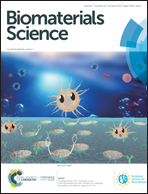The sulfation of biomimetic glycosaminoglycan substrates controls binding of growth factors and subsequent neural and glial cell growth†
Abstract
Sulfated glycosaminoglycans (GAGs) are key structural and functional extracellular matrix (ECM) molecules involved in numerous signaling pathways mainly through their interaction with growth factors. Alginate sulfate mimics sulfated GAGs and binds growth factors such as basic fibroblast growth factor (FGF-2). Here, natural biomimetic substrates were engineered by immobilizing biotinylated alginate sulfates with varying degrees of sulfation (DS, from 0 to 2.7) on gold and polystyrene substrates using biotin–streptavidin binding. The build-up of films and the effect of the DS and biotinylation method on FGF-2 binding were assessed using quartz crystal microbalance with dissipation monitoring (QCM-D) and immunohistochemistry. The role of substrate sulfation and FGF-2 loading on the growth of A172 (human glioblastoma multiforme), SH-SY5Y (human neuroblastoma), and PC-12 (rat pheochromocytoma) cell lines was evaluated in vitro using proliferation and neurite outgrowth assessment. An increase in the DS of alginates resulted in augmented FGF-2 binding as evidenced by higher frequency and dissipation shifts measured with QCM-D and confirmed with immunostaining. All sulfated alginate substrates supported the attachment and growth of neural/glial cell lines better than controls with the highest increase in cell proliferation observed for the highest DS (p < 0.05 for all the cell lines). Moreover, FGF-2 loaded substrates with the highest DS induced the most significant increase in neurite-positive PC-12 cells and average neurite length. The developed biomimetic coatings can be used to functionalize substrates for biosensing applications (e.g. gold substrates) and to induce defined cellular responses via controlled growth factor delivery for basic and applied sciences.



 Please wait while we load your content...
Please wait while we load your content...